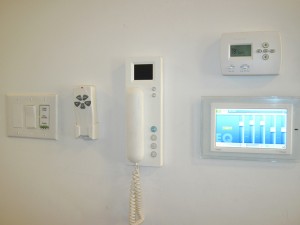

You have dinner in the oven, you opened the door for the deliveryman, you alerted the authorities of a possible intruder on your neighbor’s property and you surveyed your pantry to create a grocery list. Sounds like you’ve had a pretty normal day, except that you have completed all of these tasks from your office, miles away from your house. Welcome to the convenience of living in the smart home of the future.
While smart home technology currently cannot support all of these tasks, it is quickly moving toward a state of complete home automation and remote user control.
“Smart homes are a culmination of products and functionality,” said Utz Baldwin, the CEO of the Custom Electronic Design and Installation Association (CEDIA). “What makes a house smart for me will be different than what makes a house smart for you. It comes down to the needs of the homeowner.”
There are three important components of a smart home system: the network, the user interface, and the user. The network is all of the wires and cables that allow the aspects of the house to communicate with each other and the user. The interface is the medium in which the user interacts with the network. Many smart houses have multiple interfaces such as, mobile phone applications and wall-mounted touch-screens. Lastly, the user controls and programs all of the functions of the house. It takes all three of these parts working together in order for the smart house to be efficient and effective.
“You do not always need to add new systems,” said Patrick Griffin, owner of Philadelphia Smart Home. “The smart system can work with your existing systems and just get more out of it and provide more capabilities.”
Philadelphia Smart Home is a technology installation company that specializes in smart home technology.
There are many popular features currently available to make your house smarter, including: climate control, lighting, security and entertainment. All of these systems could then be controlled remotely through an internet-ready device.
“The technology is advancing at such a pace that it makes it easier for the consumer to get the information and control the things they want from just about anywhere,” said Baldwin.
Smart homes have the ability to allow owners to control and automate their thermostats. According to Baldwin, homeowners can set-up a system where the control unit opens or closes a window’s blinds based on the time of day and position of the sun. This would reduce that amount of time the air conditioning or heat needs to run, cutting down on electric use.

Smart homeowners can also combine many or all of their light switches into one easy to uses switch or touch-pad. It also allows users to create different lighting presets, like a setting that would automatically dim the lights for a movie for instance.
The Energy Conservation Enhancement Project found that dimming the lights by 50 percent can save 40 percent of electricity and it extends the life of the bulb 20 times. You also can program the smart system to turn on the foyer light if the front door is opened at night, according to Griffin.
Enhancing a home’s security is one of the most popular smart home systems. Smart security allows the user to view who is at the front door on the intercom. It also provides 24/7 video surveillance that can be viewed from any computer. Motion sensors can also provide real-time information about the movements in the house. According to Griffin a smart house could alert the homeowner when their child enters the house by using individualized security codes.
Simplifying entertainment is another feature of smart homes. Users can control the music throughout the house from a central control panel. They can also program settings that automatically begin when an event occurs. For example, a specific playlist can begin to play when a particular person enters their security code upon entering the front door, Griffin notes.
“Historically the primary reason for smart home technology has been convenience or the simplification of systems,” said Baldwin. Simplifying a system can be combining all your light switches into one unit, or taking a complicated TV and DVD remote and putting all of the important features into a simple touch-screen. It is important, then, for smart home technology to be as simple and user-friendly as possible. Baldwin said, “Quite often if technology is too difficult for the consumer they end up abandoning it.”
While smart homes are not necessarily green, and green homes are not necessarily smart, the two concepts have a lot of overlapping features. For instance energy-use reduction is a primary motivator for both technologies. The biggest innovation on the horizon is smart grid technology and smart meters.

“There is going to be a way to monitor your electrical meter so that you can monitor your electric use. For example if you have lights on in your house, you can turn off those lights and watch your usage go down,” said Griffin. This will give people more control of their energy costs. Also smart grid technology may allow people to consume more energy when rates are lower and vice-versa.
Smart house technology also improves green house technology by giving homeowners more control over the systems in their house. Without smart technology it would be harder to dramatically lessen your carbon emissions, according to Baldwin.
“With technology the sky is the limit as it relates to what you can do,” said Baldwin.
Also visit our other story on smart/green technology
https://vimeo.com/20332114]
[swfobject]https://smcsites.com/soundslides/uploads/sp1036techphillysmarthouse/sp1036techphillysmarthouse.swf, 550, 700[/swfobject]


Be the first to comment